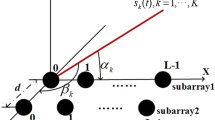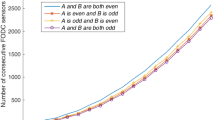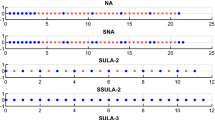Abstract
Sparse arrays can increase the array aperture and degrees of freedom through the construction of either sum or difference co-arrays or both. In order to exploit the advantages of sparse arrays while estimating directions of arrival (DOAs) of a mixture of circular and non-circular signals, in this paper, a gridless DOA estimation method is proposed by employing a recently introduced enhanced nested array, whose virtual arrays have no holes. The virtual signals derived from both sum and difference co-arrays are constructed based on atomic norm minimization. It is shown that the proposed method also works when the circular and non-circular signals come from the same set of directions. Simulation results are provided to demonstrate the performance of the proposed method.





Similar content being viewed by others
Data Availability Statement
The data included in this study may be available upon reasonable request by contacting with the corresponding author.
References
B.N. Bhaskar, G. Tang, B. Recht, Atomic norm denoising with applications to line spectral estimation. IEEE Trans. Signal Process. 61(23), 5987–5999 (2013). https://doi.org/10.1109/TSP.2013.2273443
J. Cai, W. Liu, R. Zong, B. Wu, Sparse array extension for non-circular signals with subspace and compressive sensing based doa estimation methods. Signal Process. 145, 59–67 (2018). https://doi.org/10.1016/j.sigpro.2017.11.012
H. Chen, C. Hou, W. Liu, W.P. Zhu, M.N.S. Swamy, Efficient two-dimensional direction-of-arrival estimation for a mixture of circular and noncircular sources. IEEE Sens. J. 16(8), 2527–2536 (2016). https://doi.org/10.1109/JSEN.2016.2517128
H. Chen, C. Hou, W.P. Zhu, W. Liu, Y. Dong, Q. Wang, Joint diagonalization based 2d doa estimation for mixed circular and strictly noncircular sources. in 2017 IEEE Radar Conference (RadarConf), pp. 0001–0005 (2017). https://doi.org/10.1109/RADAR.2017.7944160
H. Chen, C. Hou, W.P. Zhu, W. Liu, Y.Y. Dong, Z. Peng, Q. Wang, Esprit-like two-dimensional direction finding for mixed circular and strictly noncircular sources based on joint diagonalization. Signal Process. 141, 48–56 (2017). https://doi.org/10.1016/j.sigpro.2017.05.024
H. Chen, W. Wang, W. Liu, Joint doa, range, and polarization estimation for rectilinear sources with a cold array. IEEE Wirel. Commun. Lett. 8(5), 1398–1401 (2019). https://doi.org/10.1109/LWC.2019.2919542
X. Chen, X. Zhang, J. Yang, M. Sun, How to overcome basis mismatch: From atomic norm to gridless compressive sensing. Acta Autom. Sin. 42(3), 335–346 (2016). https://doi.org/10.16383/j.aas.2016.c150539
P. Chevalier, A. Blin, Widely linear mvdr beamformers for the reception of an unknown signal corrupted by noncircular interferences. IEEE Trans. Signal Process. 55(11), 5323–5336 (2007)
R. Cohen, Y.C. Eldar, Sparse convolutional beamforming for ultrasound imaging. IEEE Trans. Ultrason. Ferroelectr. Freq. Control 65(12), 2390–2406 (2018). https://doi.org/10.1109/TUFFC.2018.2874256
F. Gao, A. Nallanathan, Y. Wang, Improved music under the coexistence of both circular and noncircular sources. IEEE Trans. Signal Process. 56(7), 3033–3038 (2008). https://doi.org/10.1109/TSP.2007.916123
M. Guo, Y.D. Zhang, T. Chen, Doa estimation using compressed sparse array. IEEE Trans. Signal Process. 66(15), 4133–4146 (2018). https://doi.org/10.1109/TSP.2018.2847645
A. Liu, G Liao, Q. Xu, C. Zeng, A circularity-based doa estimation method under coexistence of noncircular and circular signals, in 2012 IEEE International Conference on Acoustics, Speech and Signal Processing (ICASSP), pp. 2561–2564 (2012). https://doi.org/10.1109/ICASSP.2012.6288439
C. Liu, P. Vaidyanathan, Super nested arrays: lnear sparse arrays with reduced mutual coupling-part ii: High-order extensions. IEEE Trans. Signal Process. 64(16), 4203–4217 (2016). https://doi.org/10.1109/TSP.2016.2558167
C. Liu, P.P. Vaidyanathan, Super nested arrays: linear sparse arrays with reduced mutual coupling-part i: fundamentals. IEEE Trans. Signal Process. 64(15), 3997–4012 (2016). https://doi.org/10.1109/TSP.2016.2558159
C. Liu, P.P. Vaidyanathan, P. Pal, Coprime coarray interpolation for doa estimation via nuclear norm minimization. in 2016 IEEE International Symposium on Circuits and Systems (ISCAS), pp. 2639–2642 (2016). https://doi.org/10.1109/ISCAS.2016.7539135
C.L. Liu, P. Vaidyanathan, Cramér-rao bounds for coprime and other sparse arrays, which find more sources than sensors. Digital Signal Process. 61, 43–61 (2017). https://doi.org/10.1016/j.dsp.2016.04.011. Special Issue on Coprime Sampling and Arrays
Z. Liu, Z. Huang, Y. Zhou, J. Liu, Direction-of-arrival estimation of noncircular signals via sparse representation. IEEE Trans. Aerosp. Electron. Syst. 48(3), 2690–2698 (2012). https://doi.org/10.1109/TAES.2012.6237619
M. Lustig, D.L. Donoho, J.M. Santos, J.M. Pauly, Compressed sensing mri. IEEE Signal Process. Mag. 25(2), 72–82 (2008). https://doi.org/10.1109/MSP.2007.914728
P. Pal, P.P. Vaidyanathan, Nested arrays: a novel approach to array processing with enhanced degrees of freedom. IEEE Trans. Signal Process. 58(8), 4167–4181 (2010). https://doi.org/10.1109/TSP.2010.2049264
B. Picinbono, P. Chevalier, Widely linear estimation with complex data. IEEE Trans. Signal Process. 43(8), 2030–2033 (1995)
G. Qin, M.G. Amin, Y.D. Zhang, Doa estimation exploiting sparse array motions. IEEE Trans. Signal Process. 67(11), 3013–3027 (2019)
S. Qin, Y.D. Zhang, M.G. Amin, Generalized coprime array configurations for direction-of-arrival estimation. IEEE Trans. Signal Process. 63(6), 1377–1390 (2015). https://doi.org/10.1109/TSP.2015.2393838
A. Raza, W. Liu, Q. Shen, Thinned coprime array for second-order difference co-array generation with reduced mutual coupling. IEEE Trans. Signal Process. 67(8), 2052–2065 (2019). https://doi.org/10.1109/TSP.2019.2901380
R. Roy, T. Kailath, Esprit-estimation of signal parameters via rotational invariance techniques. IEEE Trans. Acoust. Speech Signal Process. 37(7), 984–995 (1989). https://doi.org/10.1109/29.32276
R. Schmidt, Multiple emitter location and signal parameter estimation. IEEE Trans. Antennas Propag. 34(3), 276–280 (1986). https://doi.org/10.1109/TAP.1986.1143830
Q. Shen, W. Liu, W. Cui, S. Wu, Y.D. Zhang, M.G. Amin, Low-complexity direction-of-arrival estimation based on wideband co-prime arrays. IEEE ACM Trans. Audio Speech Lang. Process. 23(9), 1445–1456 (2015). https://doi.org/10.1109/TASLP.2015.2436214
J. Steinwandt, F. Roemer, M. Haardt, G. Del Galdo, Deterministic cramér-rao bound for strictly non-circular sources and analytical analysis of the achievable gains. IEEE Trans. Signal Process. 64(17), 4417–4431 (2016). https://doi.org/10.1109/TSP.2016.2566603
J. Steinwandt, F. Roemer, M. Haardt, G.D. Galdo, R-dimensional esprit-type algorithms for strictly second-order non-circular sources and their performance analysis. IEEE Trans. Signal Process. 62(18), 4824–4838 (2014). https://doi.org/10.1109/TSP.2014.2342673
P. Stoica, E.G. Larsson, A.B. Gershman, The stochastic crb for array processing: a textbook derivation. IEEE Signal Process. Lett. 8(5), 148–150 (2001). https://doi.org/10.1109/97.917699
G. Tang, B.N. Bhaskar, P. Shah, B. Recht, Compressed sensing off the grid. IEEE Trans. Inf. Theory 59(11), 7465–7490 (2013). https://doi.org/10.1109/TIT.2013.2277451
L. Teng, Q. Wang, H. Chen, W. Zhu, W. Liu, J. Cai, Doa estimation for coexistence of circular and non-circular signals based on atomic norm minimization, in 2020 IEEE 11th Sensor Array and Multichannel Signal Processing Workshop (SAM), pp. 1–5 (2020). https://doi.org/10.1109/SAM48682.2020.9104368
P.P. Vaidyanathan, P. Pal, Sparse sensing with co-prime samplers and arrays. IEEE Trans. Signal Process. 59(2), 573–586 (2011). https://doi.org/10.1109/TSP.2010.2089682
Q. Wang, X. Wang, H. Chen, X. Zhu, W. Liu, W. Yan, L. Wang, An effective localization method for mixed far-field and near-field strictly non-circular sources. Digital Signal Process. 94, 125–136 (2019). https://doi.org/10.1016/j.dsp.2019.06.003. Special Issue on Source Localization in Massive MIMO
X. Wang, Z. Chen, S. Ren, S. Cao, Doa estimation based on the difference and sum coarray for coprime arrays. Digital Signal Process. 69, 22–31 (2017). https://doi.org/10.1016/j.dsp.2017.06.013. http://www.sciencedirect.com/science/article/pii/S1051200417301276
X. Wang, L. Wan, M. Huang, C. Shen, K. Zhang, Polarization channel estimation for circular and non-circular signals in massive mimo systems. IEEE J. Select. Top. Signal Process. 13(5), 1001–1016 (2019). https://doi.org/10.1109/JSTSP.2019.2925786
X. Wu, W.P. Zhu, J. Yan, A toeplitz covariance matrix reconstruction approach for direction-of-arrival estimation. IEEE Trans. Veh. Technol. 66(9), 8223–8237 (2017). https://doi.org/10.1109/TVT.2017.2695226
X. Wu, W.P. Zhu, J. Yan, A high-resolution doa estimation method with a family of nonconvex penalties. IEEE Trans. Veh. Technol. 67(6), 4925–4938 (2018). https://doi.org/10.1109/TVT.2018.2817638
X. Wu, W.P. Zhu, J. Yan, Gridless two-dimensional doa estimation with l-shaped array based on the cross-covariance matrix, in 2018 IEEE International Conference on Acoustics, Speech and Signal Processing (ICASSP), pp. 3256–3260 (2018). https://doi.org/10.1109/ICASSP.2018.8461481
Z. Zheng, Y. Huang, W.Q. Wang, H.C. So, Direction-of-arrival estimation of coherent signals via coprime array interpolation. IEEE Signal Process. Lett. 27, 585–589 (2020). https://doi.org/10.1109/LSP.2020.2982769
Z. Zheng, S. Mu, Two-dimensional doa estimation using two parallel nested arrays. IEEE Commun. Lett. 24(3), 568–571 (2020). https://doi.org/10.1109/LCOMM.2019.2958903
Z. Zheng, W. Wang, Y. Kong, Y.D. Zhang, Misc array: a new sparse array design achieving increased degrees of freedom and reduced mutual coupling effect. IEEE Trans. Signal Process. 67(7), 1728–1741 (2019). https://doi.org/10.1109/TSP.2019.2897954
C. Zhou, Y. Gu, X. Fan, Z. Shi, G. Mao, Y.D. Zhang, Direction-of-arrival estimation for coprime array via virtual array interpolation. IEEE Trans. Signal Process. 66(22), 5956–5971 (2018). https://doi.org/10.1109/TSP.2018.2872012
C. Zhou, Y. Gu, S. He, Z. Shi, A robust and efficient algorithm for coprime array adaptive beamforming. IEEE Trans. Veh. Technol. 67(2), 1099–1112 (2018). https://doi.org/10.1109/TVT.2017.2704610
Acknowledgements
This work is sponsored by the National Natural Science Foundation of China under Grant Nos. 61871282 and 62001256, the Key Laboratory of Intelligent Perception and Advanced Control of State Ethnic Affairs Commission under Grant MDIPAC-2019102, and by Zhejiang Provincial Natural Science Foundation of China under Grant No. LQ19F010002.
Author information
Authors and Affiliations
Corresponding author
Additional information
Publisher's Note
Springer Nature remains neutral with regard to jurisdictional claims in published maps and institutional affiliations.
Part of the work in this paper has been published by 11th IEEE Sensor Array and Multichannel Signal Processing Workshop (SAM 2020) conference [31]
Rights and permissions
About this article
Cite this article
Teng, L., Wang, Q., Chen, H. et al. Atomic Norm-Based DOA Estimation with Sum and Difference Co-arrays in Coexistence of Circular and Non-circular Signals. Circuits Syst Signal Process 40, 5033–5053 (2021). https://doi.org/10.1007/s00034-021-01708-7
Received:
Revised:
Accepted:
Published:
Issue Date:
DOI: https://doi.org/10.1007/s00034-021-01708-7




